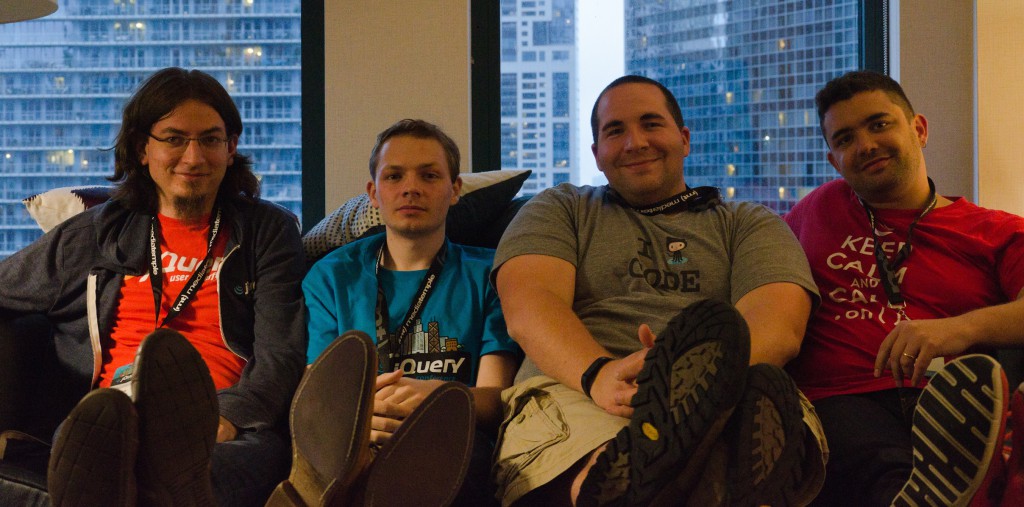Season’s greetings! After a thoughtful review of the Naughty and Nice lists, we have decided to leave a small present under the tree to finish 2014: jQuery 1.11.2 and 2.1.3! These releases include several bug fixes to make your cross-browser development experience better.
The most significant fix in this release is a workaround for a serious querySelector bug in Safari 8.0 and 7.1. When this bug popped up we were hopeful that it would be fixed in patch releases but that did not happen. Apple is by far the least transparent browser maker, and we have very little information about when the Webkit patch for this bug might be pulled into Safari. As a result, we have decided to patch this in Sizzle, the selector engine used by jQuery.
A bug like this one emphasizes the benefit of using a library like jQuery rather than going directly to the DOM APIs. Even modern browsers can suffer from bugs that aren’t fixed for a long time, and there are still cross-browser feature differences with several browsers in wide use such as Android 2.3. Special-case code for obscure browser issues can seem unnecessary until you spend a day trying to debug a problem in your own code caused by one. Or worse, lose a paying customer because they couldn’t use your site from their old phone.
Another bug that makes it difficult for us to test jQuery on iOS 8 is that the user agent of the simulator is incorrect so the iOS 8 simulator is not recognized by our unit test infrastructure. The fix for that issue is very simple but Apple won’t tell us if we can count on it being done. For now we’re doing our iOS 8 testing manually.
In addition, this release includes several changes inside jQuery to avoid holding onto DOM elements unnecessarily. Although the old code generally wouldn’t cause things to run incorrectly, web pages might run slowly and use more memory than necessary.
You may notice that we skipped a patch release number in the 2.x branch. We didn’t actually skip it, we built it and found a problem that caused problems when jQuery was used with node. (Many thanks to Denis Sokolov for letting us know immediately and prodding us to fix it!) Rather than shipping those files to the other CDNs, we decided to create new releases.
As far as the potential for compatibility or regression issues, we believe this is a very low-risk upgrade for anyone currently using 1.11.1 or 2.1.1. We are making this release ahead of jQuery 3.0 to ensure that you can use a Safari-safe version of jQuery without the need to review your code for compatibility with changes being anticipated in jQuery 3.0. If you do encounter bugs, in upgrading from the previous version, please let us know.
You can include these files directly from the jQuery CDN if you like, or copy them to your own local server. The 1.x branch includes support for IE 6/7/8 and the 2.x branch does not.
https://code.jquery.com/jquery-1.11.2.js
https://code.jquery.com/jquery-2.1.3.js
These updates are already available as the current versions on npm and Bower. Information on all the ways to get jQuery is available at https://jquery.com/download/. Public CDNs receive their copies today, please give them a few days to post the files and don’t be impatient. If you’re anxious to get a quick start, just use the files on our CDN until they have a chance to update.
Many thanks to all of you who participated in this release by testing, reporting bugs, or submitting patches, including Chris Antaki, Denis Sokolov, Jason Bedard, Julian Aubourg, Liang Peng, Michał Gołębiowski, Oleg Gaidarenko, PashaG, Richard Gibson, Rodrigo Rosenfeld Rosas, Timmy Willison, and TJ VanToll.
Since the last release of jQuery we have moved from a Trac installation to GitHub issues, so there are currently tickets for this release in both bug trackers. References to the Trac tickets have been migrated to GitHub issues, however, so you can use this GitHub Issues query to review all the tickets.
Thanks for all your support, and see you at jQuery 3.0!


